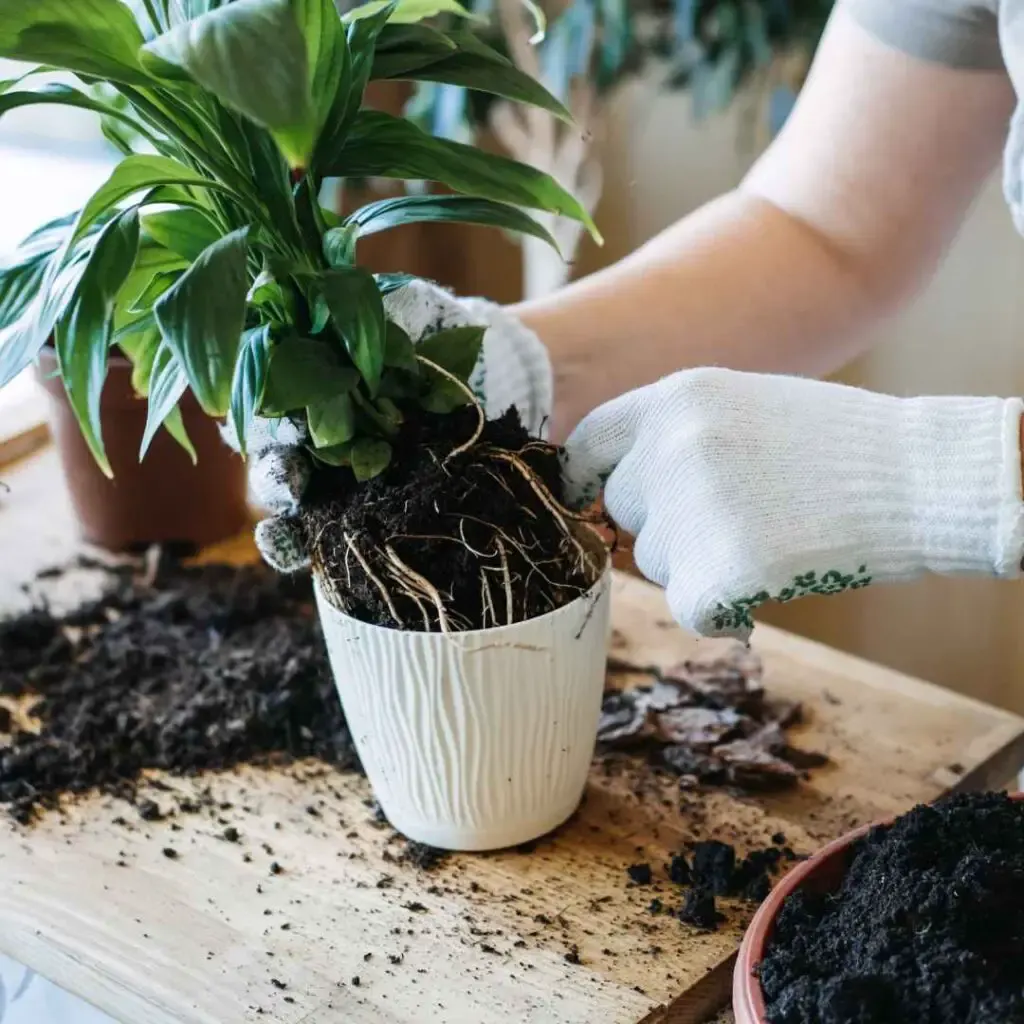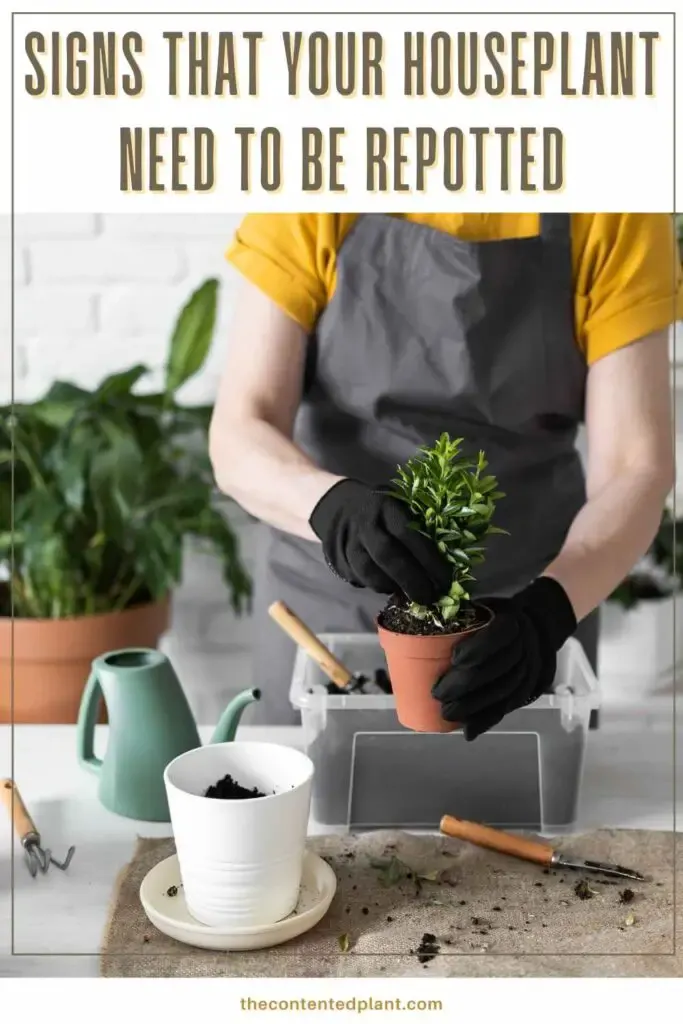Knowing the signs that your houseplant needs to be repotted is an important aspect of plant ownership. The reality is, all plants will eventually need to be repotted in order to thrive and grow for potentially many years. The process of repotting plants doesn’t have to be stressful; in fact, some find it refreshing and therapeutic. Often times the most challenging part of repotting houseplants is knowing if and when you should.
Planning ahead for the inevitable task of repotting is half the battle, after that it’s just a matter of knowing the signs for your specific plant and how to repot your plant safely and effectively. We are going to be discussing the signs that your houseplant needs to be repotted in this post.

How can your tell if your plant needs to be repotted?
There are quite a few signs to look for when it comes to repotting your plants. From soil condition and container size, to the appearance of the plants leaves and the health of the roots; knowing what your plant is telling you is very important. All plants will begin to show signs that repotting is needed, so be sure to keep an eye on it and take action quickly to keep your houseplant in strong health.
What are the most commons signs that your houseplant needs to be repotted?
One of the most likely signs that your houseplant needs to be repotted is known as a ‘root bound’ or ‘pot bound’ plant. This is when the roots of your plant are becoming tightly bound together, or are bursting from the container that they are currently living in.
When plants are growing outdoors they have plenty of room to spread and begin new offshoots; container plants are prevented from doing this because they live in confined spaces. Because of this, they will need to be moved to a larger container and pruned to prevent overgrowth and root binding which will eventually kill the plant.

Look for These Signs that Your Plant May be Root Bound.
- Roots are becoming exposed through the top of the soil
- The roots are growing out the bottom of the drainage holes
- The plant is drying out quicker than it should
- The roots are becoming intertwined and tightly bound together
- The plant is showing general signs of distress in appearance
Is the Soil a Problem?
Another very common reason for needing to repot your plants is a lack of nutrients in the soil. This will occur over time even with a regular fertilizing schedule. Soil that is confined to a container will not have the ability to replenish its nutrients like soil outdoors can. For this reason it is vital that plants receive new soil every so often.
It’s even possible that the soil may be incorrect for that specific plant. Different plants require different levels of drainage, oxygen, ph levels, and soil structure. Sometimes plants that you have recently purchased could be living in less that ideal soil for their particular needs to thrive. This would be another very important reason to repot your plant.
Look Up the Care Guide For your plant in Our Houseplant Section
Finding the right soil for certain plants
Some plants very clearly require specific soil in order to survive. We have some posts that take in depth looks at soils and the structure needed to keep your plants happy and healthy.
- The best soil for Snake Plants
- The best soil for Succulents
- Each of our specific plant profile posts discuss what soil mixtures that plant will thrive in, so be sure to search the blog for your plant if you have questions
- Many of our care guides have videos like the one below to walk you through the process
- Some plants require more specific needs like we discuss in how to repot an orchid successfully
The type of container or pot that your plant is living in is just as important as the soil. The proper drainage, moisture retention, size, and breathability of the container will all affect the health of your plants.
Signs that your plant could be struggling with the container include:
- The plant is outgrowing the container and simply needs a larger pot
- You are beginning to see early signs of root rot which include white residue on the roots. This is very common with pot with no drainage holes and aroid plants that cannot take overwatering.
- When the soil is staying very moist for long periods and not draining efficiently this can be a sign of root binding. Your pot is too small.
- The plant is dry and droopy which can indicate too much drainage. Or again a small pot with only a little exhausted soil available to the roots.
Educating yourself on the various types of containers, as well as your plants specific needs is not only extremely important, it is also well worth the time.
Take a Look at our posts on proper containers for succulents and orchids.
Troubleshooting an unhealthy or unhappy plant can be confusing and very time consuming. Take the time to learn what your plant needs to minimize stress on yourself and your beautiful houseplant. We have a guide to houseplants for beginners that will break down not only the care, but also the best plants to start with if you are new to this world.

Certain Pest infestations May Require immediate repotting for all of your houseplants:
A pest infestation is always the most dreaded experience of any houseplant owner. Pests will not only damage the plant, they will multiply quickly, spread to other plants, and hang around through multiple life cycles if not eradicated fully and immediately.
Once you have removed the pests and taken all of the necessary steps to ensure a safe and pest free environment, get ready to repot your plants. This will further ensure that no pests, larvae, or eggs are living in the soil or container of the plants.
The appearance of your plant can indicate it is time to repot
We can all recognize when a plant appears unhealthy. Drooping, yellowed, or dry leaves are almost always a sign that something is amiss. When a plant is wilted or sickly looking it’s always time to troubleshoot what could be going on. It doesn’t necessarily mean repotting is needed; but, it could mean it will be needed soon.
The appearance of your plant is one of the clearest signs that your houseplant needs to be repotted, but make sure you take the time to rule out any other possible issues such as pests, over or under watering, fertilizing problems, or trouble with sunlight exposure.

When is the best time to repot?
As a general rule it is best to repot your plants in spring. This season is when the roots of your plant will be in their active growth phase which is best for withstanding the shock and transition of repotting. This is also the season that plants will receive and absorb fertilizer most efficiently, which will aid in the acclimation period that it will go through.
It’s always a good idea to repot any new plants
Most plants that you purchase from a nursery or store will come in a generic plastic pot. If yours did it’s a great idea to repot it as soon as possible to a container better suited for that plants specific needs. Whether terra cotta, ceramic, hanging, or simply a larger pot; your new plant will do much better in a good quality container.
Be sure to research which kind of pot your new plant requires, and make sure it has the proper drainage. Many containers are showy, but don’t have the right drainage holes. This is another very important step to take before bringing home your new plant.
Don’t worry! Repotting your houseplants is not as scary or challenging as you may think
We have many resources on the blog to help you navigate repotting your plants, and care for them in the specific ways they require for their genus. The best thing to do is plan ahead and make sure you have the necessary tools, soil, and containers ready for when the time comes.
This Post on How to Repot Will Support the repotting process every step of the way
Be sure to give your plant some time to acclimate to it’s new pot and the fresh soil. All plants can be expected to go through a short time of shock. This is normal and not cause for concern. The plant should settle into its new pot and perk up in no time with the proper care and routine.
Follow Us:
Find us on YouTube, Instagram , Pinterest and TikTok! We love to Plant chat. We also comment, like and occasionally share your content to our daily stories. We’d love to see your plants. Share your joy in your houseplants. Happy Planting!

